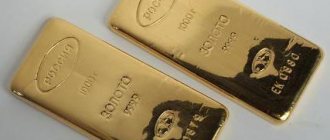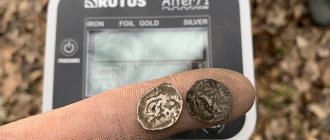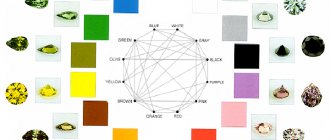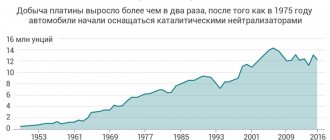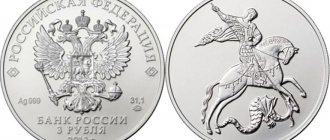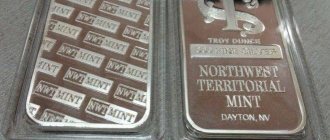One of the services of modern banks is the sale of precious metal bars to individuals. Particularly popular are gold and silver bars, the purchase of which allows bank clients to disperse their savings across several types, choosing the most appropriate option for each individual to preserve and increase their savings. To deal with bullion, every person needs some general knowledge about gold bullion, silver bullion, platinum bullion and palladium bullion. For example, what types of bars are there, what do they look like externally, what marks should be poured on them, how can you find out the standard of gold (silver, platinum, palladium) or the weight of the bar? Regulations of the Central Bank of the Russian Federation dated November 1, 1996 N 50 “On the performance of transactions with precious metals by credit institutions on the territory of the Russian Federation and the procedure for conducting banking transactions with precious metals” approved by Order of the Central Bank of the Russian Federation dated November 1, 1996 N 02-400 introduced concepts that and determine the work with ingots:
- Banks are credit organizations that, in accordance with the established procedure, have received a license (permission) from the Bank of Russia to carry out transactions with precious metals.
- Precious metals are bars of gold, silver, platinum and palladium, as well as coins made of precious metals (gold, silver, platinum and palladium), with the exception of coins that are the currency of the Russian Federation.
- Precious metal bars are standard or measured bars of Russian production, corresponding to state standards in force in the Russian Federation, and foreign production, corresponding to international quality standards adopted by the London Bullion Market Association (LBMA) and London Platinum and Palladium Market Participants (LPPM) .
To comply with the requirements of the London Bullion Market Association (LBMA) and the London Platinum Group Metals Association (LPMG), precious metal bars produced by Russian factories and meeting the requirements of national and international standards comply with the following parameters:
- composition with a certain admixture,
- a certain shape
- a certain mass.
All precious metal bars bear mandatory marks, which include:
- Serial number;
- Try;
- Letters of precious metals;
- Manufacturer's mark;
- Year of manufacture;
- Bar weight in grams or ounces.
Of the marks listed above, the sample is in a special place. Sample is a kind of quality sign. When applied to precious metals - gold, silver, platinum and palladium - hallmark has two meanings:
- this is a state mark, a guarantee of the usefulness of bars or coins in circulation;
- This is an indication of the weight content of the precious metal in a unit of the alloy.
In accordance with the metric system, the sample shows how many grams of precious metals are contained in 1000 grams of the product.
Pure metal corresponds to the 1000th sample. The Regulations of the Central Bank of the Russian Federation dated November 1, 1996 N 50 speaks of two types of Russian-made precious metal ingots:
- Standard Ingots
- Ingots
Bank operations with bullion and investment coins
Transactions with precious metals in banks are one of the areas of activity under special control by the Bank of Russia.
At the same time, both the Bank of Russia itself and commercial banks must be guided by an extensive list of legislative acts and regulations (more than 40). The entire regulatory framework can be grouped into several levels: Operations with precious metals can be carried out by commercial banks that have a universal license from the Bank of the Russian Federation to work with funds in rubles and foreign currency.
In accordance with Federal Law No. 41-FZ “On Precious Metals and Precious Stones” dated March 26, 1998, precious metals include: gold, silver, platinum and platinum group metals (palladium, iridium, rhodium, ruthenium and osmium).
Banks have the right to conduct transactions with refined precious metals (purified from all kinds of impurities), which comply with state standards of the Russian Federation or international quality standards and are in the form of bars and coins made of gold, silver, platinum and palladium. The exception is coins that are the currency of the Russian Federation. In addition, precious metals include:
– powders of platinum group metals (platinum, palladium, rhodium), manufactured by Russian refining organizations, marked by the manufacturer and meeting the state packaging standard (glass flasks or plastic jars); the content of chemically pure base precious metal (99.90% of the alloy mass of the powder);
Alloy mass refers to the actual total mass of the alloy or powder containing the precious metal. The percentage of precious metal in an alloy or powder is called fineness;
– rolled products are cold-rolled strips of precious metals that are added as makeweights to batches of the corresponding precious metals in ingots in order to achieve a given batch weight;
– granules – refined silver in granules, which are added as makeweights to batches of silver in standard bars to achieve a given batch weight.
Most often in banking practice, transactions are carried out with bullion and investment coins.
Precious metal bars are divided into standard and measured. Their characteristics are determined by Russian legislation, regulations of the Bank of Russia and the Government of the Russian Federation, taking into account the International Quality Standards adopted by the London Bullion Market Association (LBMA) and participants of the London Platinum and Palladium Market (LPPM) (as amended by Bank of Russia Directive No. 776-U dated April 11, 2000).
In table 20 indicates the characteristics established for standard ingots in accordance with current Russian quality standards for alloy mass and fineness.
Russian quality standards for standard precious metal bars
| Standard Ingots | Ligature mass, g | Sample (not less), % |
| Gold | 11 000–13 300 | 99,95 |
| Silver | 28 000–32 000 | 99,9 |
| Platinum | No more than 5,500 | 99,9 |
| Palladium | No more than 3,500 | 99,9 |
Dimensional ingots are ingots manufactured and marked at Russian refineries and foreign production, weighing 1 kg or less and containing at least 99.99% of the chemically pure precious metal of the alloy mass. On November 25, 1995, Decree of the Government of the Russian Federation No. 1157 “On additional measures to develop the market of precious metals and precious stones in the Russian Federation” was adopted. This decree introduced the characteristics of dimensional ingots presented in table. 21.
Characteristics of dimensional ingots valid on the territory of the Russian Federation
| Ingots | Ligature mass, g | Sample, % |
| Gold | 1, 5, 10, 20, 50, 100, 250, 500, 1 000 | Highest 99.99 |
| Silver | 50, 100, 250, 500, 1 000 | Highest 99.99 |
| Platinum | 5, 10, 20, 50, 100 | Not lower than 99.95 |
| Palladium | 5, 10, 20, 50, 100 | Not lower than 99.95 |
The quality standards for precious metals adopted by the London Bullion Market Association and members of the London Platinum and Palladium Market are referred to as the London good delivery standard. A refinery that affixes its hallmark to London good delivery bullion must be included in a special list of the LBMA or LPPM. The list includes 55 gold companies from 28 countries; 68 companies from 27 countries for silver; 30 companies from 10 countries for platinum; 23 companies from 9 countries for palladium. In Russia, Novosibirsk, Prioksky, Krasnoyarsk and a number of other refineries have the corresponding status for all four precious metals.
The London good delivery standard contains a number of general requirements for quality standards for precious metal bullion:
Individual characteristics of precious metal bars according to the London good delivery standard are presented in table. 22.
London good delivery standard for precious metal bullion
| Type of metal | Ligature weight, troy ounce (tu) or grams (g) | Sample, % |
| Gold | 350–450 tu (weight ratio 0.025 tu) | 99,5 |
| Silver | 500–1,250 tu (weight ratio 0.10 tu) | 99,9 |
| Platinum | 32,150–192,904 tu | 99,95 |
| Palladium | 32,150–192,904 tu | 99,95 |
To carry out transactions with precious metals, banks must equip special premises (on the territory of the cash register) with weighing instruments and scales. Premises and equipment must comply with the State Standard and the requirements of the Bank of Russia, set out in Bank of Russia Instruction No. 94-I “On the procedure for determining the mass of precious metals and precious stones and calculating their value in the Bank of Russia and credit institutions” dated November 30, 2000.
The mass of a chemically pure precious metal is determined by multiplying the mass in the alloy by the alloy sample, presented as a decimal fraction, in which all the digits of the sample value are placed after the decimal point.
For example, when weighing a gold bar, the scale reading is 12,348.43 g. The ligature mass will be determined by rounding the weight of the bar to tenths of a unit and, accordingly, will be 12,348.4 g, after which the mass of chemically pure gold in the bar is determined. It will be equal to 12,347.2 g (12,348.4 x 0.9999 = 12,347.16).
The cost of precious metals is determined in accordance with the Bank of Russia methodology set out in Bank of Russia Instruction No. 94-I dated November 30, 2000 (clause 3).
In order to determine the cost of a precious metal ingot, it is necessary to multiply the price of the corresponding precious metal in Russian rubles per 1 gram by a unit of quantitative accounting (gram with an accuracy of 0.1).
If the terms of the transaction require valuation in US dollars per troy ounce, then to determine the cost of the precious metal in Russian rubles, you must perform the following steps:
– convert the mass of precious metal from grams to troy ounces by dividing the number of grams in the bar by the number 31.1035 with an accuracy of 0.001 troy ounces and observing the rounding rule;
For example, the mass of chemically pure gold in an ingot is 12,459.6 g, which is equal to 400.585 troy ounces (12,459.6: 31.1035 = 400.5851).
– the resulting value of the mass of the precious metal in troy ounces should be multiplied by the price of this precious metal in US dollars. The official world price for gold is determined on the London Stock Exchange in US dollars per troy ounce; prices for gold, silver, platinum and palladium are also determined on world trading floors (New York, Tokyo, etc.). It should be noted that the London fixing for precious metals, set twice a day, is the main reference point when concluding contracts for the supply of precious metals and when determining the contract price;
– in order to convert the price of a precious metal into the ruble equivalent, it is necessary to multiply the price in dollars by the value of the official ruble to dollar exchange rate established by the Bank of Russia on the day of calculating the cost of the precious metal.
The Bank of Russia sets official discount prices for precious metals every working day at 14:00 Moscow time. Prices are calculated based on the fixing for gold, silver, platinum and palladium on the London SPOT spot metal market and are converted into rubles at the official US dollar to Russian ruble exchange rate effective on the day following the day the discount prices were set. Bank of Russia discount prices are used for accounting purposes in credit institutions in the Russian Federation. Discount prices are posted on the official website of the Bank of Russia on the Internet.
One of the forms of precious metals is investment coins, which are primarily a hoarding instrument, the issuer of which is the state Central Bank. It is mandatory to indicate on the coin: the name of the issuer, the type and purity of the precious metal, the weight and denomination of the coin.
The price of a bullion coin is determined by the value of the precious metal from which it is made. As a rule, the value of a bullion coin fully corresponds to the weight of the precious metal indicated on it.
Characteristic features of bullion coins are: normal quality of minting, large circulation and simplicity of design.
In the Russian Federation, investment coins are issued by the Bank of Russia. The investment coins in circulation issued by the Bank of Russia are presented in table. 23.
Investment coins of the Bank of Russia in circulation as of 01/01/2019
| Denomination, rubles | Name | Metal/sample | Weight | Year of issue | |
| Total, g | Content of chemically pure metal not less than, g | ||||
| 3 | Sable | Silver 925/1000 | 33,93 | 31,1035 | 1995 |
| 50 | St. George the Victorious | Gold 999/1000 | 7,89 | 7,78 | 2006–2011; 2013–2015; 2018–2019 |
| 3 | St. George the Victorious | Silver 999/1000 | 31,5 | 31,1 | 2009–2011; 2015–2019 |
| 100 | Leopard | Gold 999/1000 | 15,82 | 15,55 | 2011 |
| 3 | Polar bear | Silver 999/1000 | 31,5 | 31,1 | 2012 |
| 50 | Polar bear | Gold 999/1000 | 7,95 | 7,78 | 2012 |
| 100 | Polar bear | Gold 999/1000 | 15,82 | 15,55 | 2012 |
| 3 | Bunny | Silver 999/1000 | 31,5 | 31,1 | 2013 |
| 50 | Bunny | Gold 999/1000 | 7,95 | 7,78 | 2013 |
| 100 | Bunny | Gold 999/1000 | 15,82 | 15,55 | 2013 |
| 3 | FIFA World Cup 2022 in Russia | Silver 999/1000 | 31,5 | 31,1 | 2016 |
| 100 | FIFA World Cup 2022 in Russia | Gold 999/1000 | 15,82 | 15,55 | 2016 |
There are also chervonets (sower) gold coins in circulation, which were issued by the State Bank of the USSR in the period from 1975 to 1982.
When conducting banking operations with precious metals, the Bank of Russia exercises control over the activities of banks in this direction.
The following are subject to verification by the Bank of Russia:
Banking operations with precious metals include operations to attract deposits and place precious metals. The list of banking operations and transactions is presented in Federal Law No. 395-1 dated December 2, 1990 “On Banks and Banking Activities”:
Transactions for the purchase and sale of precious metals are carried out with the delivery of precious metals in physical form or reflected in accounts, and are also divided into cash and forward transactions.
Cash transactions include purchase and sale transactions with immediate delivery, when the delivery date of cash and precious metals (value date) is set within two business days from the date of the transaction. If settlements for the supply of metal and cash are carried out on different value dates, this condition must be specifically agreed upon between the parties at the time of the transaction and reflected in the contract (legally recorded).
Futures transactions include purchase and sale transactions when the settlement period for the transaction is more than two business days from the date of conclusion of the transaction.
In addition to forward transactions for the purchase and sale of precious metals, banks can carry out forward transactions in the form of options, swaps, futures and other transactions in accordance with Russian legislation and international banking practice.
All monetary claims and obligations arising from transactions in precious metals between residents of the Russian Federation must be denominated and paid in the currency of the Russian Federation.
Transactions for the purchase and sale of precious metals are concluded in accordance with the General Agreement on the General Conditions for Conducting Transactions for the Purchase and Sale of Precious Metals on the territory of the Russian Federation, developed by the Bank of Russia and applied in business transactions by banks of the Russian Federation.
Credit organizations are actively engaged in transactions for the purchase and sale of investment and collection (commemorative) coins of both Russian and foreign origin.
First of all, the bank must purchase coins made of precious metals. For this purpose, banks send their applications for the purchase of Russian coins to the territorial offices of the Bank of Russia twice a year. In turn, divisions of the Bank of Russia, based on the application received from the bank, send the specification to it. The document indicates the number of coins allocated to the bank, their value and payment terms. Coins are sold by the Bank of Russia at selling prices, including the face value of the coin, the cost of the precious metals contained in them, the cost of producing coins and overhead costs for their delivery from mints to interregional storage facilities. After payment, the coins are delivered to the bank’s vault independently by its collection service.
Russian banks purchase foreign-made coins, as a rule, with the help of intermediary companies. All actions related to the delivery of coins are carried out by the supplier company. Searching for the required coins, placing an order in foreign mints, delivery, insurance, payment of customs duties and customs brokerage services, payment of VAT, presentation of coins to the assay office, delivery of coins to the bank vault and other specially agreed costs are included in the cost of the coin.
The sale of coins made of precious metals is carried out by banks as a regular cash transaction, with the preparation of appropriate cash documents.
Repurchase (purchase) of coins is a more complex operation for banks, as it requires compliance with the rules and regulations for the purchase and sale of precious metals. First of all, the cash desk of a coin repurchase point (additional office or bank branch) must be equipped with special equipment that makes it possible to determine the alloy grade of the coin, its weight and safety. A bank employee involved in the redemption of coins must undergo special training and have the appropriate certificate. He should also have coin catalogs at his disposal, which contain all the characteristics, detailed descriptions and images of the coins. However, despite significant financial investments in organizing transactions for the purchase and sale of coins made of precious metals, banks are quite actively involved in such operations. Firstly, the bank replenishes coin reserves without additional costs for delivery from the Bank of Russia; secondly, the price of purchasing a coin from a client is lower than the purchase price, which gives the bank additional income; thirdly, the range of coins sold is supported by the purchase of coins from earlier years of issue and having not only an investment, but also a numismatic component in the price.
Bank accounts in precious metals. Banks of the Russian Federation conduct operations with precious metals with the opening of metal accounts. Metal accounts are opened for individuals and legal entities, including banks.
To store precious metals, banks open metal safekeeping accounts. The bank client transfers refined precious metal in bullion for safekeeping. A special feature of metal accounts for safekeeping is the recording of precious metals on them while preserving their individual characteristics: name, quantity of valuables, fineness, manufacturer, serial number of the ingot, etc. Precious metals accepted for safekeeping cannot be placed by the bank on its own behalf and for its own account. account, since they are not borrowed funds from the bank.
The sequence of operations for receiving (issuing) precious metal by a bank is as follows:
1. The client submits an application to the bank to open an account and enters into a corresponding agreement with the bank. The bank opens an account for the client and issues an account opening certificate. The bank begins to accept (issue) precious metals on the basis of the corresponding client’s order no later than three working days from the date of receipt of the order. Moreover, within one day the bank accepts (issues) precious metals in an amount of no more than 5 tons.
2. Precious metals are accepted for safekeeping in the bank’s vault according to an acceptance certificate, which is signed on the one hand by the financially responsible employee of the bank, on the other - by the client or his representative acting on the basis of a power of attorney. In this case, precious metals are accepted (issued) in one batch. Ingots undergo continuous visual inspection, they are counted, each ingot is weighed and the obtained data is compared with the data of accompanying documents and state industry standards in force in the Russian Federation or international quality standards. Upon completion of the acceptance (issuance) of precious metals, one copy of the acceptance and transfer certificate remains in the bank, and the second is transferred to the client.
3. Based on the acceptance and transfer certificate for precious metals, the bank credits (writes off) precious metals to the metal account for safekeeping, about which the bank client receives the corresponding document - an extract from the personal account no later than the next business day after the transaction on the account.
Metal custody accounts are also used to transfer precious metals from one client’s account to another client’s account opened with a bank. In this case, the owner of the account to which the precious metal is transferred must confirm in writing his consent to the crediting of precious metals to his account by transfer of precious metals from the account of another client. The client from whose account precious metals are written off submits a corresponding transfer order to the bank.
The bank is obliged to ensure the safety of precious metals transferred to it for safekeeping, as well as to ensure the confidentiality of information about the client’s precious metals and transactions on metal safekeeping accounts.
The closure of a metal custody account is carried out at the request of the client or by decision of the bank. In the first case, the issuance of precious metals from the client’s account is carried out within three working days after receiving his application.
In the second case, the period for issuing precious metals is 10 business days from the date the client’s bank receives written notification of its intention to close the account.
If the client fails to fulfill his obligation to receive precious metals from the bank's vault when closing the metal account for safekeeping (termination of the account agreement), the bank has the right, after written notification to the client, to sell the precious metals in its custody at the price of purchase of precious metals by the Bank of Russia on the day of the transaction ( Part 2, Article 899 of the Civil Code of the Russian Federation). Upon completion of the transaction, the bank reimburses its expenses for the sale of the client’s precious metals, and transfers the remaining amount of proceeds from the sale of metals to the client’s account.
Standard gold bars (silver, platinum, palladium) and their purity
Standard bars
are precious metal bars manufactured and marked by Russian (until 1992 - Soviet) refining organizations in accordance with current state and industry standards, which have the following weight and fineness denominations:
| Precious metal bars | Ligature mass (ingot weight), grams | Try |
| Gold bars | 11000-13300 | no less than 999.5 |
| Silver bars | 28000-32000 | not less than — 999.0 |
| Platinum bars | No more than 5500 | not less than — 999.0 |
| Palladium Ingots | No more than 3500 | not less than — 999.0 |
For clarity, I will provide images of products of OJSC Krasnoyarsk Non-Ferrous Metals Plant named after V.N. Gulidov", as well as their denominations of mass and fineness:
- Gold in standard bars, GOST 28058-89.
The content of the main component is 99.99%, the weight of the ingots is from 11.0 to 13.3 kg. Gold in standard bars - Silver in standard bars, GOST 28595-90.
Main component content 99.99%; weight of ingots from 28.0 to 32.0 kg, it is possible to obtain metal of higher purity and any weight Silver in standard ingots - Platinum ingots, GOST 12341-81, 14837-79.
The content of the main component is from 99.95 to 99.98%; It is possible to obtain metal of higher purity. Platinum bullion - Palladium ingots, 12340-81, 14836-82... Main component content from 99.95 to 99.98%;
It is possible to obtain metal of higher purity. Palladium bullion
Metal bills
Operations to attract deposits and place precious metals are carried out using impersonal metal accounts.
Unallocated metal accounts are opened to record precious metals and carry out operations to attract and place them without indicating the individual characteristics of the metal. Precious metals recorded on impersonal metal accounts have a quantitative description of the mass of the metal and a balance sheet value. In other words, impersonal metal accounts are analogues of ordinary bank current accounts, with the difference that metal accounts account not for rubles, but for impersonal precious metals (in grams).
Banks open the following types of impersonal metal accounts for individuals and legal entities (including for banks in the form of correspondent accounts):
The Bank of Russia determines the general conditions for conducting transactions with precious metals using impersonal metal accounts (Table 24).
Storing savings in impersonal metal accounts has a number of features:
Commercial banks determine and specify all the conditions for transactions with precious metals on an impersonal metal account in the agreement concluded when opening this account. The agreement defines: operations carried out on this account; conditions for crediting and returning precious metals from the account; the amount and procedure for paying remunerations related to maintaining an account; change in the individual characteristics of precious metals when they are credited and issued from an account in physical form and the deviation of the mass of metal listed on an impersonal metal account from the mass of metal to be returned from this account in physical form.
It should be noted that the existing conditions for conducting transactions with precious metals on impersonal metal accounts in Russian banks are almost the same. This is explained by the fact that there is an Agreement on the basic conditions for the Bank of Russia to carry out purchase and sale transactions of precious metals on the territory of the Russian Federation, which was developed and approved by the Bank of Russia (Information letter of the Bank of Russia dated December 19, 2019 No. IN-01-19/96 " On the form of an agreement on the main conditions for the Bank of Russia to carry out transactions for the purchase and sale of precious metals on the territory of the Russian Federation."
In table 25 presents the main terms of the agreement for an impersonal metal account using the example of Sberbank PJSC.
Basic terms of agreements for impersonal metal accounts with Sberbank PJSC as of 06/01/2020.
| Type of metal | Minimum metal weight, g | Deposit term | Purchase (sale) price | Accrual of % on account balances | Fee for opening an account and storing metal | The procedure for adding (receiving) metal |
| Gold, silver, platinum, palladium | 0,1 1 0,1 0,1 | Not provided | Bank quote on the day of the transaction | Not produced | For free | In monetary terms |
In 2022, changes were made in the Russian Federation to legislative acts regulating the activities of banks, including in the field of operations with precious metals. The fundamental law is Federal Law No. 212-FZ “On Amendments to Parts One and Two of the Civil Code of the Russian Federation and Certain Legislative Acts of the Russian Federation” dated July 26, 2017 (latest edition).
In accordance with this law, impersonal metal accounts have been renamed into bank accounts in precious metals. However, this name applies only to agreements concluded by banks with their clients after this law came into force (from 06/01/2018).
Source
